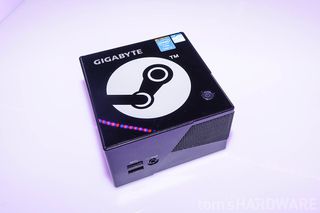Intel Gives Away Iris Pro 5200 Steam Machines to Developers
Attendees of Valve's Steam Dev Days received a little present.

Thursday during Valve's Steam Dev Days conference, Intel announced that all 1200 attendees received Gigabyte's BRIX Pro. This brick-sized Steam Machine packs Intel's Core i7-4770R system-on-a-chip (SOC) along with Intel's integrated Iris Pro 5200 graphics. This represents a sizable investment by Intel to evangelize the GT3e platform.
"This processor is a leading edge high performance 'system-on-a-chip' (SOC) with quad core CPU, Intel Iris Pro graphics and eDRAM all on a single package. This gives users highly optimized and thermally efficient computing like you see in the Gigabyte Brix, as well as mainstream gaming offerings in the market," reads Intel's latest blog.
We took a look at the Gigabyte Steam Machine during CES 2014 earlier this month. The hardware details include 8 GB of DDR3L RAM (2x 4 GB) and 1 TB of storage via a 2.5" hard drive with a SATA 3 interface (6 Gbps). Two USB 3.0 ports and a headphones/SPDIF reside on the front, and two USB 3.0 ports are provided on the back.
Based on the BRIX Pro specs, the rear I/O panel also includes HDMI output, Gigabit Ethernet, a mini-DisplayPort jack and more. Also included are Wireless AC and Bluetooth 4.0 via a pre-installed module, and one open mSATA SSD slot for adding even more storage. This unit measures 4.5 inches squared.
"The BRIX Pro is one of the first devices to boast the cutting edge graphics capabilities of Intel Iris Pro graphics. Based on the latest graphics architecture from Intel, Iris Pro Graphics use an on-package 128M eDRAM cache that negates memory pipeline issues, greatly boosting overall performance in 3D applications," reads the BRIX Pro description.
Steam Machines are expected to land in consumer hands sometime around September 2014. However, the Gigabyte BRIX Pro can be purchased in Black (i7-4770R) or Red (i5-4570R) at specific locations nationwide.
Stay On the Cutting Edge: Get the Tom's Hardware Newsletter
Join the experts who read Tom's Hardware for the inside track on enthusiast PC tech news — and have for over 25 years. We'll send breaking news and in-depth reviews of CPUs, GPUs, AI, maker hardware and more straight to your inbox.
-
stadi Why doesn't it have audio out on the back? how are you supposed to connect your speakers to this?Reply -
tntom I don't get why these are so expensive compared to building a huge ATX based system with much faster parts. The materials cost, and assembly costs of this thing is approaching Roku box levels yet it makes the MAC Pro look like a deal at $3000.Tom's can you do a performance per dollar review between this and the Mac Pro?Reply -
therealduckofdeath How about fixing those drivers first before you start thinking developers wants to optimise games for your IGP's, Intel? :)Reply -
therealduckofdeath @tmtom, shrinking parts costs money. It's always been like that. A Mac Pro is a lousy choice from a financial perspective, no matter how you twist and turn it.Reply -
sire_angelus ReplyHow about fixing those drivers first before you start thinking developers wants to optimise games for your IGP's, Intel? :)
Actually on Linux the drivers are of high quality and completely opensource(provided and developed by intel + community), speed is more or less on par with windows, the main problem might be OpenGL support stuck at 3.3 for varius reasons. The best thing is that drivers on Linux never regress and in a few months they make some incredible jumps in performance. Another good point is that intel provides the best out of the box experience for the user on Linux, no driver to be installed at all and usually they start adding the commits for future hardware 6-7 months before the actual release(there is already initial code for broadwell)
As the kaveri comparison, it's on par, but the cpu is a quad core ht so you have more raw cpu power. -
therealduckofdeath Reply12479759 said:How about fixing those drivers first before you start thinking developers wants to optimise games for your IGP's, Intel? :)
Actually on Linux the drivers are of high quality and completely opensource(provided and developed by intel + community), speed is more or less on par with windows, the main problem might be OpenGL support stuck at 3.3 for varius reasons. The best thing is that drivers on Linux never regress and in a few months they make some incredible jumps in performance. Another good point is that intel provides the best out of the box experience for the user on Linux, no driver to be installed at all and usually they start adding the commits for future hardware 6-7 months before the actual release(there is already initial code for broadwell)
As the kaveri comparison, it's on par, but the cpu is a quad core ht so you have more raw cpu power.
Uh, that's really not relevant. Since games like BF3 doesn't work on Linux.
The Windows drivers works without any issues in Windows, however, they are buggy in demanding 3D games. And since Intel don't bother fixing it on their side, game devs don't bother adding proper support for Intel IGP's for their games. Note, the GPU in a Core i5-4xxx is powerful enough to run a game like BF3 in 720p at 40+ FPS, but unfortunately, they don't bother fixing a bug that automatically crashes the game after around 10 minutes due to a memory leaks. This goes for a lot of games that run flawlessly even at 1080p, right up until the driver has wasted enough of your precious RAM.
Most Popular



